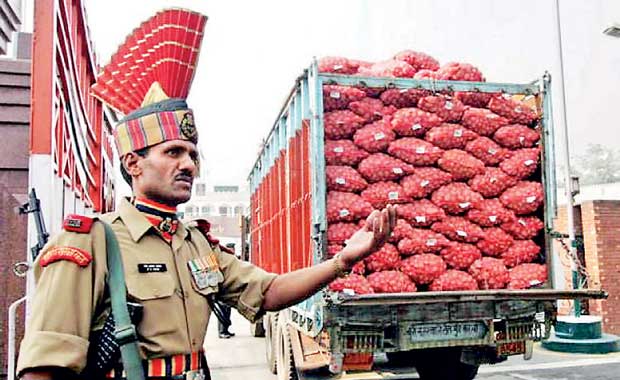10 Nov 2016 - {{hitsCtrl.values.hits}}

By Nisha Taneja and Samridhi Bimal
While formal trade between India and Pakistan is abysmally low, informal trade between the two countries has continued to thrive.
Despite various measures undertaken to normalise trade and reduce transport impediments, informal trade between India and Pakistan has continued unabated. Informal trade can be broadly defined as trade between two countries that should be included in the national income statistics, according to conventional national income accounting, but is not.
Analysts regard growing informal trade as one of the key reasons for low intra-regional trade in South Asia. An ICRIER study estimates informal trade between India and Pakistan was close to US$ 4.71 billion in 2012–13, which is almost twice the value of formal trade between the two countries in that year. Of this it is estimated that India exported US$4 billion to Pakistan and imported US$ 720 million from Pakistan.
The main items India exported informally were jewellery (24 percent), textiles (20 per cent), machinery and machine parts (8 per cent), electronic appliances (6 percent), chemicals (5 percent), paper (5 percent) and tyres (5 percent). India’s informal imports from Pakistan mainly consisted of textiles (49 percent), dried fruits (32 percent), spices (10 percent) and carpets (4 percent).
The majority of India’s informal exports to Pakistan are routed via a third country, most frequently Dubai. Third country traders based in Dubai play a key role as facilitators of buyer–seller relationships and providers of guarantees for trade transactions between Indian and Pakistani traders. About 68 per cent of India’s informal exports to Pakistan are routed via Dubai. Informal exports to Pakistan across the Line of Control (LoC) in Kashmir account for only 2 per cent.
For India’s informal imports from Pakistan, the land route is far more important than trade through a third country. About 59 percent of India’s informal imports from Pakistan are accounted for by passengers travelling by bus or rail. Informal imports through the LoC in Kashmir account for 24 percent while the remaining informal imports are through Dubai.
Bilateral economic ties
Studying informal trade is important as it provides deep insight into the functioning of the India–Pakistan bilateral economic relationship. There are three main factors driving India’s informal exports to Pakistan.
First, 50 percent of the products exported to Pakistan informally are on Pakistan’s list of items that are not allowed to be imported from India. Second, sending goods via a third country is relatively easy. This reflects the weakness of the infrastructure supporting formal trade, which often results in high transport costs in the region and creates a strong incentive for trade to take place through informal channels. Third, payment mechanisms in the formal channel are inadequate. Traders often find it difficult to send payments directly to the other country since domestic banks in both India and Pakistan do not have a presence on both sides of the border.
Other factors influencing India’s informal exports are difficulties in identifying trading partners in Pakistan, the restrictive visa regime, limited channels of communication, a lack of transparency, information asymmetries, a fear of trading directly, the imposition of high tariffs, harassment by customs officials and political tensions between the two countries.
For India’s informal imports from Pakistan, high duties imposed by India are the most important factor influencing informal trade. Other reasons included inadequate payment mechanisms in the formal channels, difficulty in meeting standards, difficulty in identifying trading partners in India, the ease of sending goods via a third country, fears of trading directly, political tensions and harassment by customs officials.
Comparing the transaction costs of trading (including transportation costs, official charges related to documentation, port charges and other informal charges) on the direct Delhi–Lahore road route and the indirect route — where goods are transported by road from Delhi to Mumbai and then transported by sea to Karachi via Dubai — finds that the indirect route is eleven times longer than the direct route, 4 times more expensive, but almost 3 times more efficient.
Inefficiency of direct route
The inefficiency of the direct route is due to several factors, including limitations on the number of items that can be exported via the road route, cumbersome customs checks at the land customs station, transaction costs in the form of bribes incurred for customs clearances, physical examination of goods and poor infrastructure. The switch to direct routes can happen only if there are substantial improvements in efficiency.
Policy and institutional factors play an important role in influencing informal trade flows between India and Pakistan. Unless the formal trade environment improves, informal trade will not only continue to coexist with formal trade, but governments will lose a significant revenue stream. The governments of India and Pakistan must recognise that informal trade markets are flourishing and that the inadequacies of the formal trade channels need to be addressed in order to improve bilateral trade relations.
(East Asia Forum) (Nisha Taneja is Professor and Samridhi Bimal is a consultant at the Indian Council for Research on International Economic Relations)
25 Nov 2024 2 hours ago
25 Nov 2024 3 hours ago
25 Nov 2024 3 hours ago
25 Nov 2024 5 hours ago
25 Nov 2024 5 hours ago